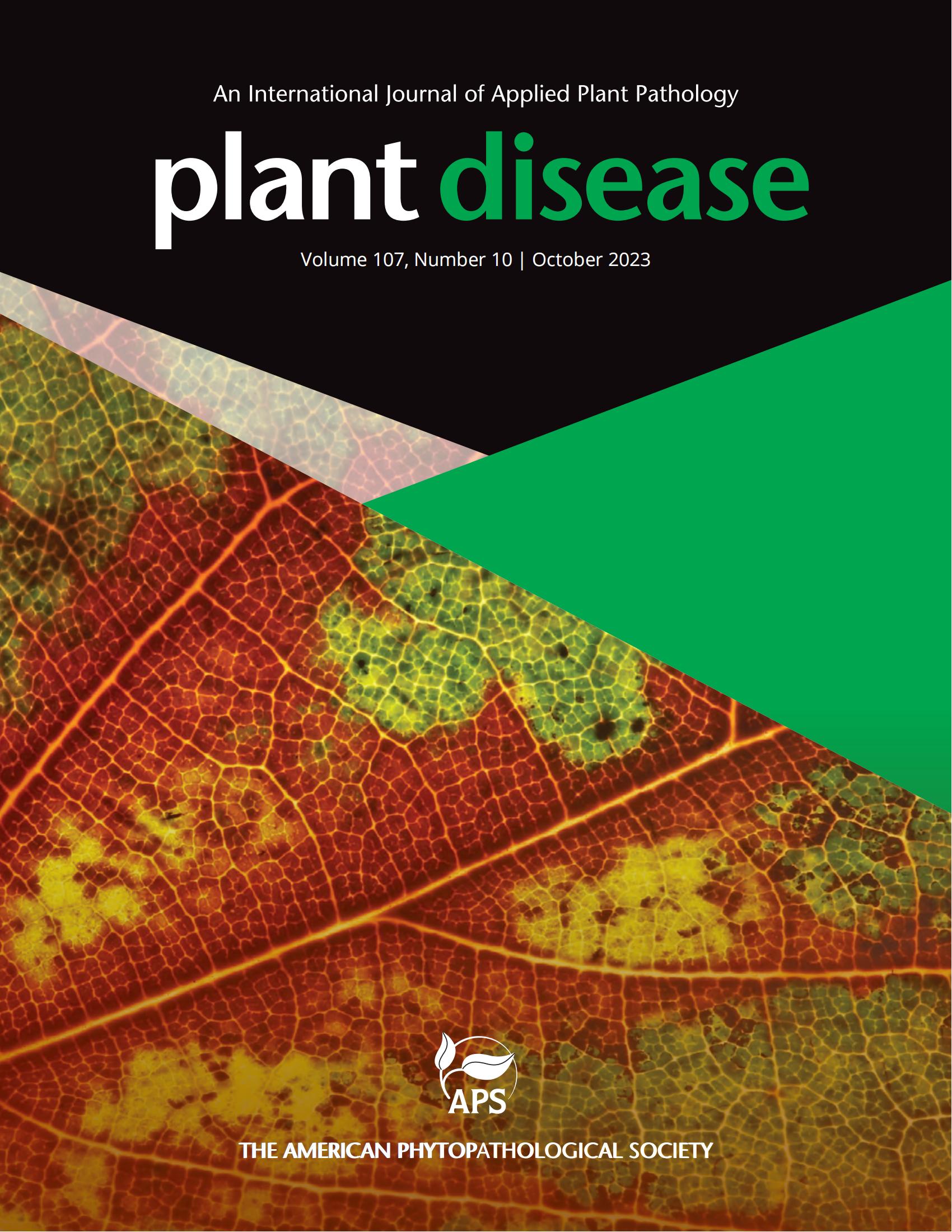中国首次报道黄单胞菌(Xanthomonas hortorum pv. vitians)是莴苣细菌性叶斑病的病原菌。
摘要
生菜(Lactuca sativa)是菊科的一种多叶蔬菜。这种冷季作物在中国的春季和秋季生长良好(Qi 等人,2021 年)。2023 年 10 月,在中国北京市延庆区永宁镇(北纬 40°53',东经 116°16')的莴苣(冰山变种)上发现了一种叶片病害,病斑呈暗褐色至黑色。在调查的温室和田间,病害发生率从 10%到 40%不等。叶片边缘出现半透明水渍状褐色病斑,随后形成大面积坏死病斑,周围有绿晕。用 75% 的乙醇浸泡感染部位 7 秒钟,再用无菌水冲洗 15 秒钟两次,然后在无菌水中切成小块。将样本提取物在营养琼脂培养基上进行过筛。培养 48 小时后,得到 12 个菌落,所有菌落均为革兰氏阴性,需氧,黄色,圆形,光滑,有光泽。筛选出具有典型特征的 SCZX1-SCZX4 株进行进一步鉴定。用细菌悬浮液(108 CFU-ml-1)喷洒三周龄的莴苣(黄油头变种),对 SCZX1-SCZX4 进行致病性试验。接种的莴苣在生长室中于 26℃、相对湿度 70% 的条件下培养。另一组莴苣植株用无菌蒸馏水进行模拟接种。每个分离物进行三次试验,每个处理包括 15 株莴苣。接种后 7-10 天内出现症状,与自然感染的生菜症状相同。阴性对照植株没有症状。用通用引物 F27/R1492(Monciardini 等人,2006 年)和特异引物(Roach 等人,2018 年)分别扩增了每个分离株的 16S rRNA 区域和两个管家基因(gyrB 和 atpD)。根据对每个分离物(Genbank登录号 PP027925、PP140779、PP140781 至 PP140783、PP137422 至 PP137428)的 BLAST 分析,对获得的序列进行 BLAST 搜索,发现 100.0% 的 16S rRNA 区域(1400/1400 个核苷酸)、100.0% 的 gyrB 区域(774/774 个核苷酸)和 100.0% 的 atpD 区域(768/768 个核苷酸)与 Xhv CFBP 498(Genbank 编号 LR828257.1)具有相同性和查询覆盖率。系统进化分析表明,SCZX1-SCZX4 与新病原型菌株 Xhv LMG 938PT 聚类,后者是从津巴布韦的一株患病荠菜中分离出来的(Timilsina, S 等人,2015 年)。SCZX1-SCZX4 的生理生化测试由 BIOLOG GENIII 微孔板系统(Biolog,Hayward,CA,USA)进行,测试结果与 Xhv LMG 938PT (Morinière,L 等人,2020 年)和 L1-L7 (Pernezny,K 等人,1995 年)一致。从重新接种的莴苣中重新分离出菌株,然后用同样的方法重新鉴定为 Xhv,满足了科赫假设。细菌性叶斑病(BLS)是由多种细菌病原体引起的一种世界性生菜病害,包括 Xhv(Dia,N.C 等人,2022 年)、Pseudomonas cichorii(Patel,N 等人,2021 年)和 P. viridiflava(Alippi,A. M 等人,1999 年)等。在土耳其(Sahin, F 等人,2000 年)、美国(Bull, C.T 等人,2007 年)、沙特阿拉伯(Al-Saleh, M 等人,2008 年)和法国(Morinière 等人,2020 年),Xhv 被广泛报道为 BLS 的致病病原体。然而,中国首次报告 Xhv 在莴苣上引起 BLS,这对于为种植者提供病原体信息以采取有效措施管理该病害具有重要意义。Lettuce (Lactuca sativa) is a leafy vegetable that belongs to the family Asteraceae. This cool-season crop grows well during Spring and Fall in China (Qi et al., 2021). In October 2023, a leaf disease with dark brown to black lesions was observed on lettuce (var. iceberg) in Yongning Town, Yanqing District, Beijing, China (40°53'N, 116°16'E). The disease incidence ranged from 10 to 40% in the surveyed greenhouse and field. Translucent and water-soaked brown spots were observed on the margins of leaf, then coalesced into large necrotic lesions surrounded by a chlorotic halo. Infected sections were soaked with 75% ethyl alcohol for 7 second, rinsed with sterile water for 15 second twice, and cut into pieces in the sterile water. The sample extracts were streaked on Nutrient agar medium. After incubation for 48 hours, 12 colonies were obtained and all the colonies were Gram-negative and aerobic with yellow, round-shape, smooth and glistening appearance. Four isolates SCZX1-SCZX4 with typical characteristics were selected for further identification tests. Pathogenicity test of SCZX1-SCZX4 was performed on the three-week-old lettuce (var. butterhead) by spraying with the bacterial suspension (108 CFU·ml-1). Inoculated lettuce were incubated at 26℃ and 70% relative humidity in the growth chamber. Another set of lettuce plants were mock inoculated with sterile distilled water. Three trials were carried out per isolate, and each treatment included fifteen lettuce plants. Symptoms appeared within 7-10 days after inoculation and are identical to those naturally infected lettuces. Negative control plants had no symptoms. The 16S rRNA region and two housekeeping genes (gyrB and atpD) of each isolate were amplified with universal primers F27/R1492 (Monciardini et al., 2006) and specific primers (Roach et al., 2018), respectively. According to BLAST analysis of each isolate (Genbank accession number PP027925, PP140779, PP140781 to PP140783, PP137422 to PP137428), BLAST searches of the obtained sequences revealed 100.0% of 16S rRNA region(1400/1400 nucleotides), 100.0% of gyrB(774/774 nucleotides), and 100.0% of atpD(768/768 nucleotides) identity and query coverage to Xhv CFBP 498 (Genbank accession number LR828257.1). Phylogenetic analysis revealed that SCZX1-SCZX4 clustered with the neopathotype strain Xhv LMG 938PT, which was isolated from a diseased L. sativa in Zimbabwe (Timilsina, S et al., 2015). Physiological and biochemical tests of SCZX1-SCZX4 were conducted by the BIOLOG GENIII microplate system (Biolog, Hayward, CA, USA), and the test results are consistent with the Xhv LMG 938PT (Morinière, L et al., 2020) and L1-L7 (Pernezny, K et al., 1995). Strains were re-isolated from re-inoculated lettuce, then re-identified as Xhv by the same method, fulfilling Koch's postulates. Bacterial leaf spot (BLS) is a worldwide-spread lettuce disease caused by numerous bacterial pathogens, including Xhv (Dia, N.C et al., 2022), Pseudomonas cichorii (Patel, N et al., 2021) and P. viridiflava (Alippi, A. M et al., 1999) etc. Xhv had been widely reported as the causal pathogen of BLS in Turkey (Sahin, F et al., 2000), United States (Bull, C.T et al., 2007), Saudi Arabia (Al-Saleh, M et al., 2008), and France (Morinière et al., 2020). However, the first report of Xhv causing BLS on lettuce in China is significant to provide pathogen information for growers in making effective measures to manage this disease.

 求助内容:
求助内容: 应助结果提醒方式:
应助结果提醒方式:


